Strategic Human Resource Management Report: University HRM3007
VerifiedAdded on 2022/08/16
|13
|3620
|69
Report
AI Summary
This report provides an in-depth analysis of Strategic Human Resource Management (SHRM) within the context of internationalizing organizations. It begins by defining International Human Resource Management (IHRM) and its significance, emphasizing the need for effective management of a global workforce. The report then explores strategies and approaches for training employees in overseas locations, focusing on the selection criteria, including technical skills, language proficiency, and cross-cultural adaptability. It also delves into the challenges faced by employees working abroad, such as staffing difficulties, cultural differences, and ethical and legal conflicts. Furthermore, the report highlights how HR practices can assist in coping with these challenges, including individualistic approaches, ethical considerations, and legal compliance. Overall, the report provides a comprehensive overview of SHRM in the international arena, offering insights into the complexities and best practices for managing human resources in a globalized environment.
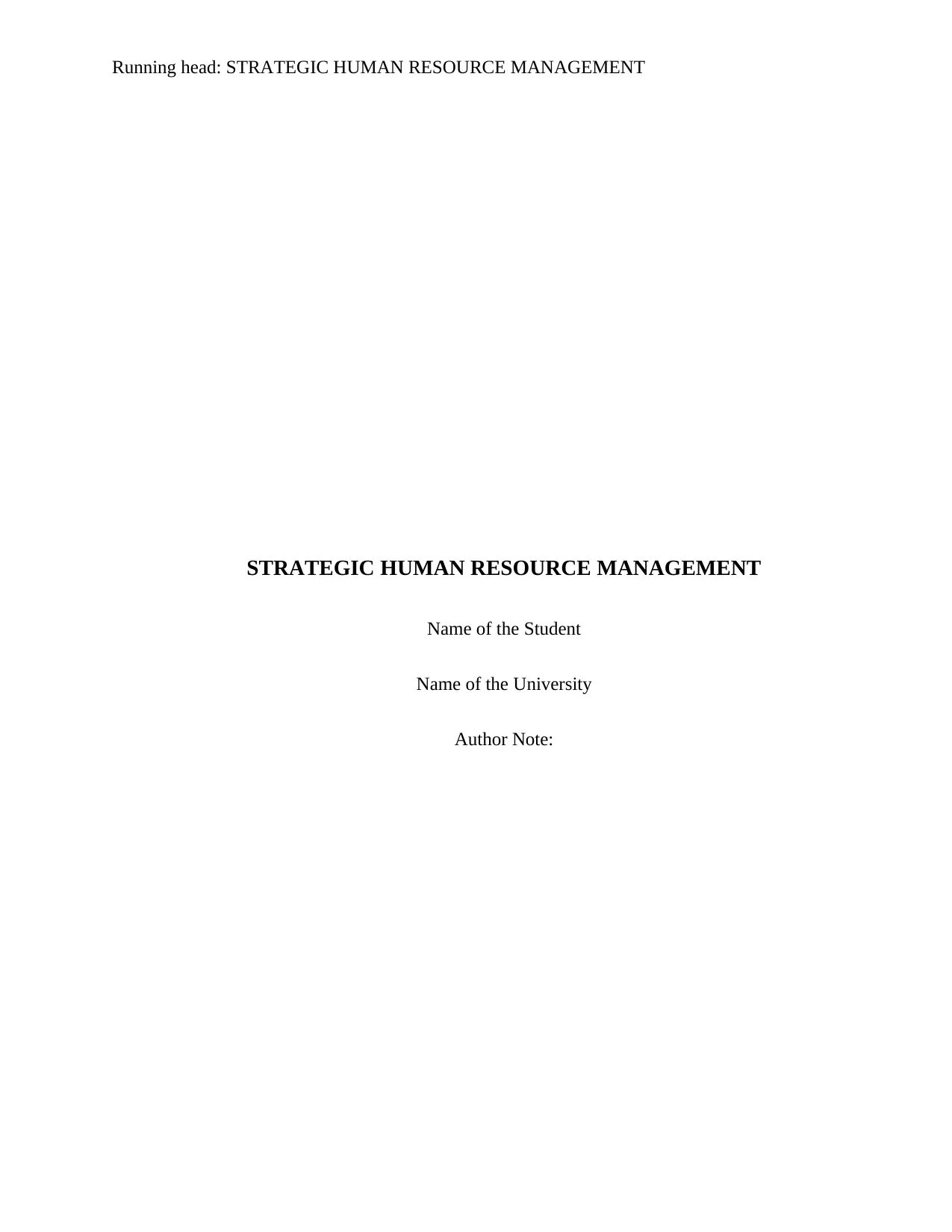
Running head: STRATEGIC HUMAN RESOURCE MANAGEMENT
STRATEGIC HUMAN RESOURCE MANAGEMENT
Name of the Student
Name of the University
Author Note:
STRATEGIC HUMAN RESOURCE MANAGEMENT
Name of the Student
Name of the University
Author Note:
Paraphrase This Document
Need a fresh take? Get an instant paraphrase of this document with our AI Paraphraser
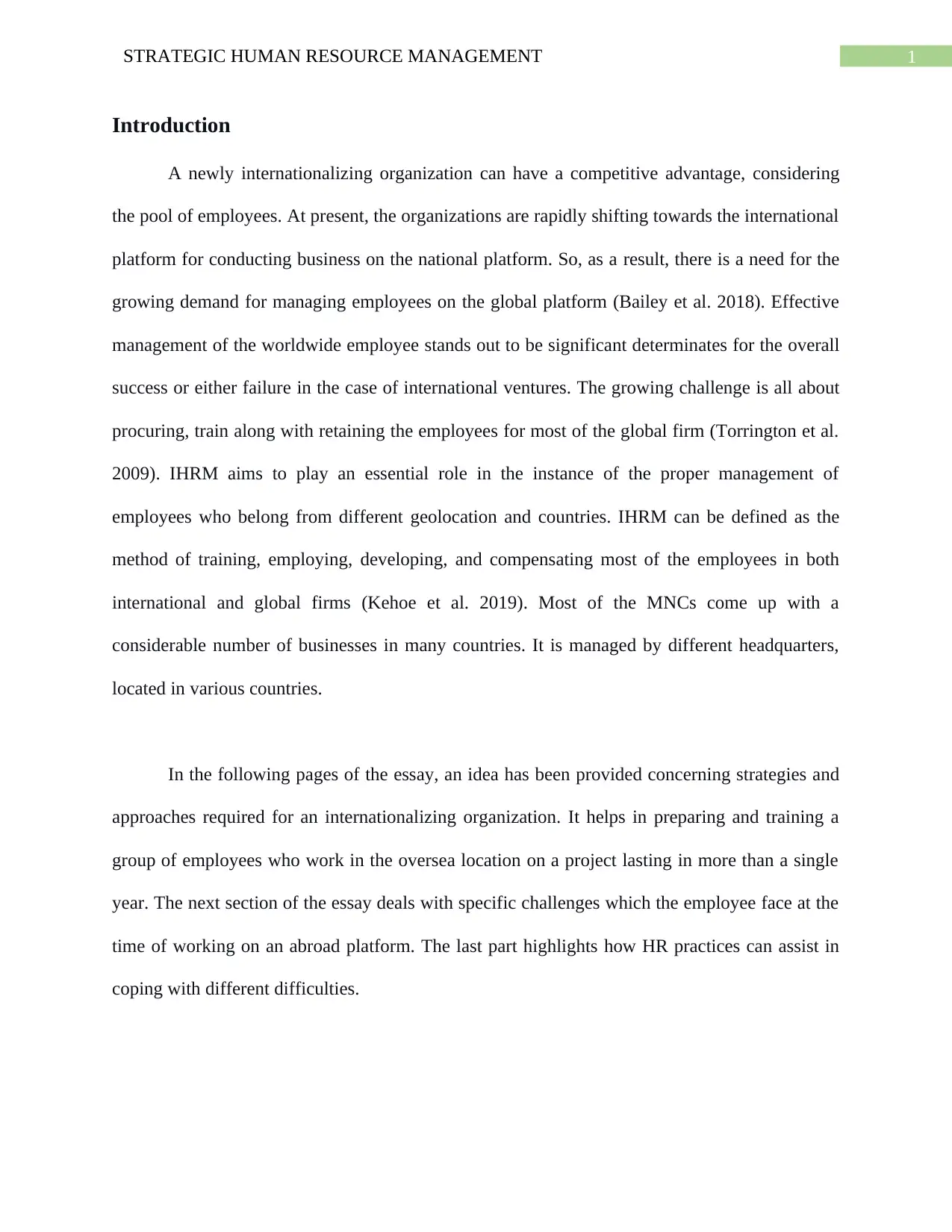
1STRATEGIC HUMAN RESOURCE MANAGEMENT
Introduction
A newly internationalizing organization can have a competitive advantage, considering
the pool of employees. At present, the organizations are rapidly shifting towards the international
platform for conducting business on the national platform. So, as a result, there is a need for the
growing demand for managing employees on the global platform (Bailey et al. 2018). Effective
management of the worldwide employee stands out to be significant determinates for the overall
success or either failure in the case of international ventures. The growing challenge is all about
procuring, train along with retaining the employees for most of the global firm (Torrington et al.
2009). IHRM aims to play an essential role in the instance of the proper management of
employees who belong from different geolocation and countries. IHRM can be defined as the
method of training, employing, developing, and compensating most of the employees in both
international and global firms (Kehoe et al. 2019). Most of the MNCs come up with a
considerable number of businesses in many countries. It is managed by different headquarters,
located in various countries.
In the following pages of the essay, an idea has been provided concerning strategies and
approaches required for an internationalizing organization. It helps in preparing and training a
group of employees who work in the oversea location on a project lasting in more than a single
year. The next section of the essay deals with specific challenges which the employee face at the
time of working on an abroad platform. The last part highlights how HR practices can assist in
coping with different difficulties.
Introduction
A newly internationalizing organization can have a competitive advantage, considering
the pool of employees. At present, the organizations are rapidly shifting towards the international
platform for conducting business on the national platform. So, as a result, there is a need for the
growing demand for managing employees on the global platform (Bailey et al. 2018). Effective
management of the worldwide employee stands out to be significant determinates for the overall
success or either failure in the case of international ventures. The growing challenge is all about
procuring, train along with retaining the employees for most of the global firm (Torrington et al.
2009). IHRM aims to play an essential role in the instance of the proper management of
employees who belong from different geolocation and countries. IHRM can be defined as the
method of training, employing, developing, and compensating most of the employees in both
international and global firms (Kehoe et al. 2019). Most of the MNCs come up with a
considerable number of businesses in many countries. It is managed by different headquarters,
located in various countries.
In the following pages of the essay, an idea has been provided concerning strategies and
approaches required for an internationalizing organization. It helps in preparing and training a
group of employees who work in the oversea location on a project lasting in more than a single
year. The next section of the essay deals with specific challenges which the employee face at the
time of working on an abroad platform. The last part highlights how HR practices can assist in
coping with different difficulties.
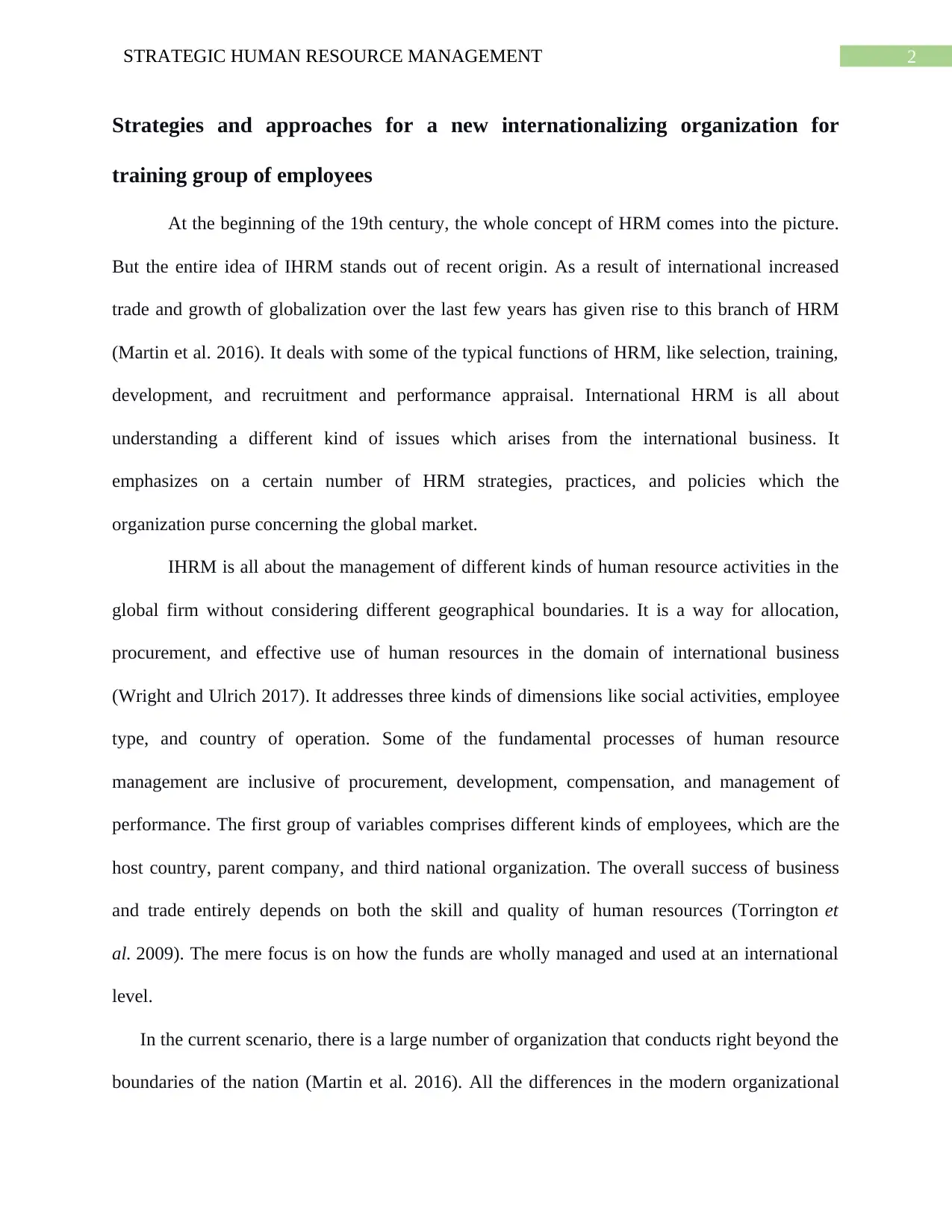
2STRATEGIC HUMAN RESOURCE MANAGEMENT
Strategies and approaches for a new internationalizing organization for
training group of employees
At the beginning of the 19th century, the whole concept of HRM comes into the picture.
But the entire idea of IHRM stands out of recent origin. As a result of international increased
trade and growth of globalization over the last few years has given rise to this branch of HRM
(Martin et al. 2016). It deals with some of the typical functions of HRM, like selection, training,
development, and recruitment and performance appraisal. International HRM is all about
understanding a different kind of issues which arises from the international business. It
emphasizes on a certain number of HRM strategies, practices, and policies which the
organization purse concerning the global market.
IHRM is all about the management of different kinds of human resource activities in the
global firm without considering different geographical boundaries. It is a way for allocation,
procurement, and effective use of human resources in the domain of international business
(Wright and Ulrich 2017). It addresses three kinds of dimensions like social activities, employee
type, and country of operation. Some of the fundamental processes of human resource
management are inclusive of procurement, development, compensation, and management of
performance. The first group of variables comprises different kinds of employees, which are the
host country, parent company, and third national organization. The overall success of business
and trade entirely depends on both the skill and quality of human resources (Torrington et
al. 2009). The mere focus is on how the funds are wholly managed and used at an international
level.
In the current scenario, there is a large number of organization that conducts right beyond the
boundaries of the nation (Martin et al. 2016). All the differences in the modern organizational
Strategies and approaches for a new internationalizing organization for
training group of employees
At the beginning of the 19th century, the whole concept of HRM comes into the picture.
But the entire idea of IHRM stands out of recent origin. As a result of international increased
trade and growth of globalization over the last few years has given rise to this branch of HRM
(Martin et al. 2016). It deals with some of the typical functions of HRM, like selection, training,
development, and recruitment and performance appraisal. International HRM is all about
understanding a different kind of issues which arises from the international business. It
emphasizes on a certain number of HRM strategies, practices, and policies which the
organization purse concerning the global market.
IHRM is all about the management of different kinds of human resource activities in the
global firm without considering different geographical boundaries. It is a way for allocation,
procurement, and effective use of human resources in the domain of international business
(Wright and Ulrich 2017). It addresses three kinds of dimensions like social activities, employee
type, and country of operation. Some of the fundamental processes of human resource
management are inclusive of procurement, development, compensation, and management of
performance. The first group of variables comprises different kinds of employees, which are the
host country, parent company, and third national organization. The overall success of business
and trade entirely depends on both the skill and quality of human resources (Torrington et
al. 2009). The mere focus is on how the funds are wholly managed and used at an international
level.
In the current scenario, there is a large number of organization that conducts right beyond the
boundaries of the nation (Martin et al. 2016). All the differences in the modern organizational
⊘ This is a preview!⊘
Do you want full access?
Subscribe today to unlock all pages.

Trusted by 1+ million students worldwide
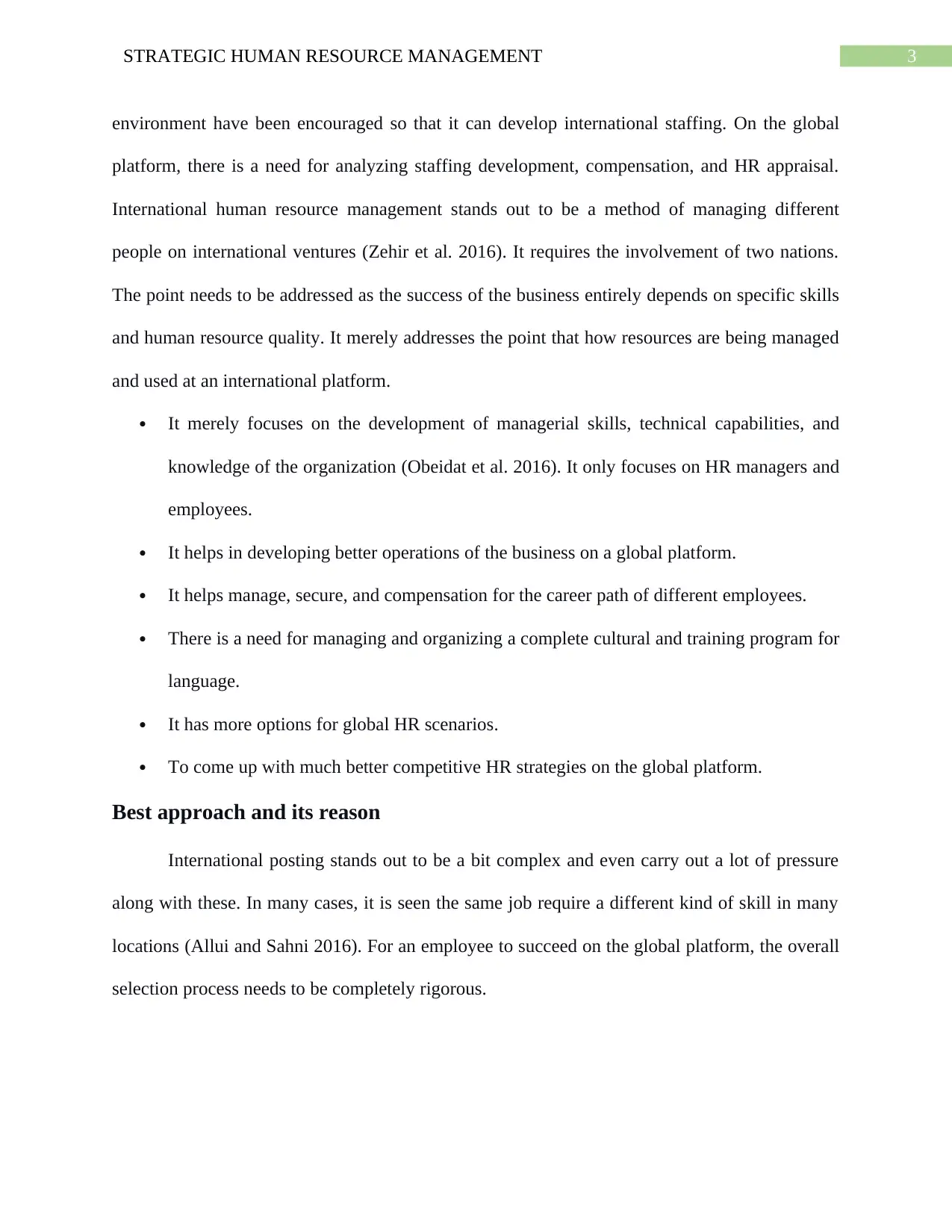
3STRATEGIC HUMAN RESOURCE MANAGEMENT
environment have been encouraged so that it can develop international staffing. On the global
platform, there is a need for analyzing staffing development, compensation, and HR appraisal.
International human resource management stands out to be a method of managing different
people on international ventures (Zehir et al. 2016). It requires the involvement of two nations.
The point needs to be addressed as the success of the business entirely depends on specific skills
and human resource quality. It merely addresses the point that how resources are being managed
and used at an international platform.
It merely focuses on the development of managerial skills, technical capabilities, and
knowledge of the organization (Obeidat et al. 2016). It only focuses on HR managers and
employees.
It helps in developing better operations of the business on a global platform.
It helps manage, secure, and compensation for the career path of different employees.
There is a need for managing and organizing a complete cultural and training program for
language.
It has more options for global HR scenarios.
To come up with much better competitive HR strategies on the global platform.
Best approach and its reason
International posting stands out to be a bit complex and even carry out a lot of pressure
along with these. In many cases, it is seen the same job require a different kind of skill in many
locations (Allui and Sahni 2016). For an employee to succeed on the global platform, the overall
selection process needs to be completely rigorous.
environment have been encouraged so that it can develop international staffing. On the global
platform, there is a need for analyzing staffing development, compensation, and HR appraisal.
International human resource management stands out to be a method of managing different
people on international ventures (Zehir et al. 2016). It requires the involvement of two nations.
The point needs to be addressed as the success of the business entirely depends on specific skills
and human resource quality. It merely addresses the point that how resources are being managed
and used at an international platform.
It merely focuses on the development of managerial skills, technical capabilities, and
knowledge of the organization (Obeidat et al. 2016). It only focuses on HR managers and
employees.
It helps in developing better operations of the business on a global platform.
It helps manage, secure, and compensation for the career path of different employees.
There is a need for managing and organizing a complete cultural and training program for
language.
It has more options for global HR scenarios.
To come up with much better competitive HR strategies on the global platform.
Best approach and its reason
International posting stands out to be a bit complex and even carry out a lot of pressure
along with these. In many cases, it is seen the same job require a different kind of skill in many
locations (Allui and Sahni 2016). For an employee to succeed on the global platform, the overall
selection process needs to be completely rigorous.
Paraphrase This Document
Need a fresh take? Get an instant paraphrase of this document with our AI Paraphraser
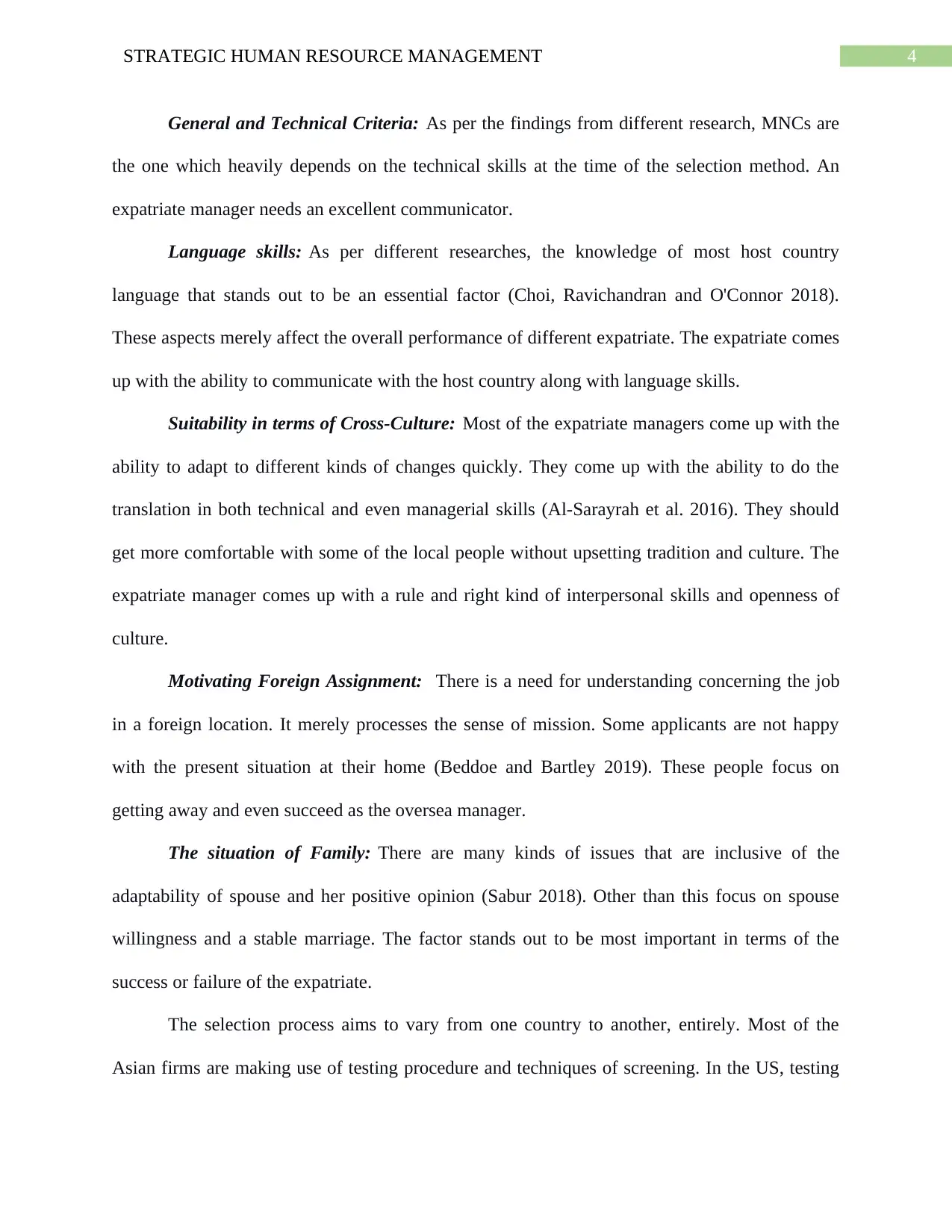
4STRATEGIC HUMAN RESOURCE MANAGEMENT
General and Technical Criteria: As per the findings from different research, MNCs are
the one which heavily depends on the technical skills at the time of the selection method. An
expatriate manager needs an excellent communicator.
Language skills: As per different researches, the knowledge of most host country
language that stands out to be an essential factor (Choi, Ravichandran and O'Connor 2018).
These aspects merely affect the overall performance of different expatriate. The expatriate comes
up with the ability to communicate with the host country along with language skills.
Suitability in terms of Cross-Culture: Most of the expatriate managers come up with the
ability to adapt to different kinds of changes quickly. They come up with the ability to do the
translation in both technical and even managerial skills (Al-Sarayrah et al. 2016). They should
get more comfortable with some of the local people without upsetting tradition and culture. The
expatriate manager comes up with a rule and right kind of interpersonal skills and openness of
culture.
Motivating Foreign Assignment: There is a need for understanding concerning the job
in a foreign location. It merely processes the sense of mission. Some applicants are not happy
with the present situation at their home (Beddoe and Bartley 2019). These people focus on
getting away and even succeed as the oversea manager.
The situation of Family: There are many kinds of issues that are inclusive of the
adaptability of spouse and her positive opinion (Sabur 2018). Other than this focus on spouse
willingness and a stable marriage. The factor stands out to be most important in terms of the
success or failure of the expatriate.
The selection process aims to vary from one country to another, entirely. Most of the
Asian firms are making use of testing procedure and techniques of screening. In the US, testing
General and Technical Criteria: As per the findings from different research, MNCs are
the one which heavily depends on the technical skills at the time of the selection method. An
expatriate manager needs an excellent communicator.
Language skills: As per different researches, the knowledge of most host country
language that stands out to be an essential factor (Choi, Ravichandran and O'Connor 2018).
These aspects merely affect the overall performance of different expatriate. The expatriate comes
up with the ability to communicate with the host country along with language skills.
Suitability in terms of Cross-Culture: Most of the expatriate managers come up with the
ability to adapt to different kinds of changes quickly. They come up with the ability to do the
translation in both technical and even managerial skills (Al-Sarayrah et al. 2016). They should
get more comfortable with some of the local people without upsetting tradition and culture. The
expatriate manager comes up with a rule and right kind of interpersonal skills and openness of
culture.
Motivating Foreign Assignment: There is a need for understanding concerning the job
in a foreign location. It merely processes the sense of mission. Some applicants are not happy
with the present situation at their home (Beddoe and Bartley 2019). These people focus on
getting away and even succeed as the oversea manager.
The situation of Family: There are many kinds of issues that are inclusive of the
adaptability of spouse and her positive opinion (Sabur 2018). Other than this focus on spouse
willingness and a stable marriage. The factor stands out to be most important in terms of the
success or failure of the expatriate.
The selection process aims to vary from one country to another, entirely. Most of the
Asian firms are making use of testing procedure and techniques of screening. In the US, testing
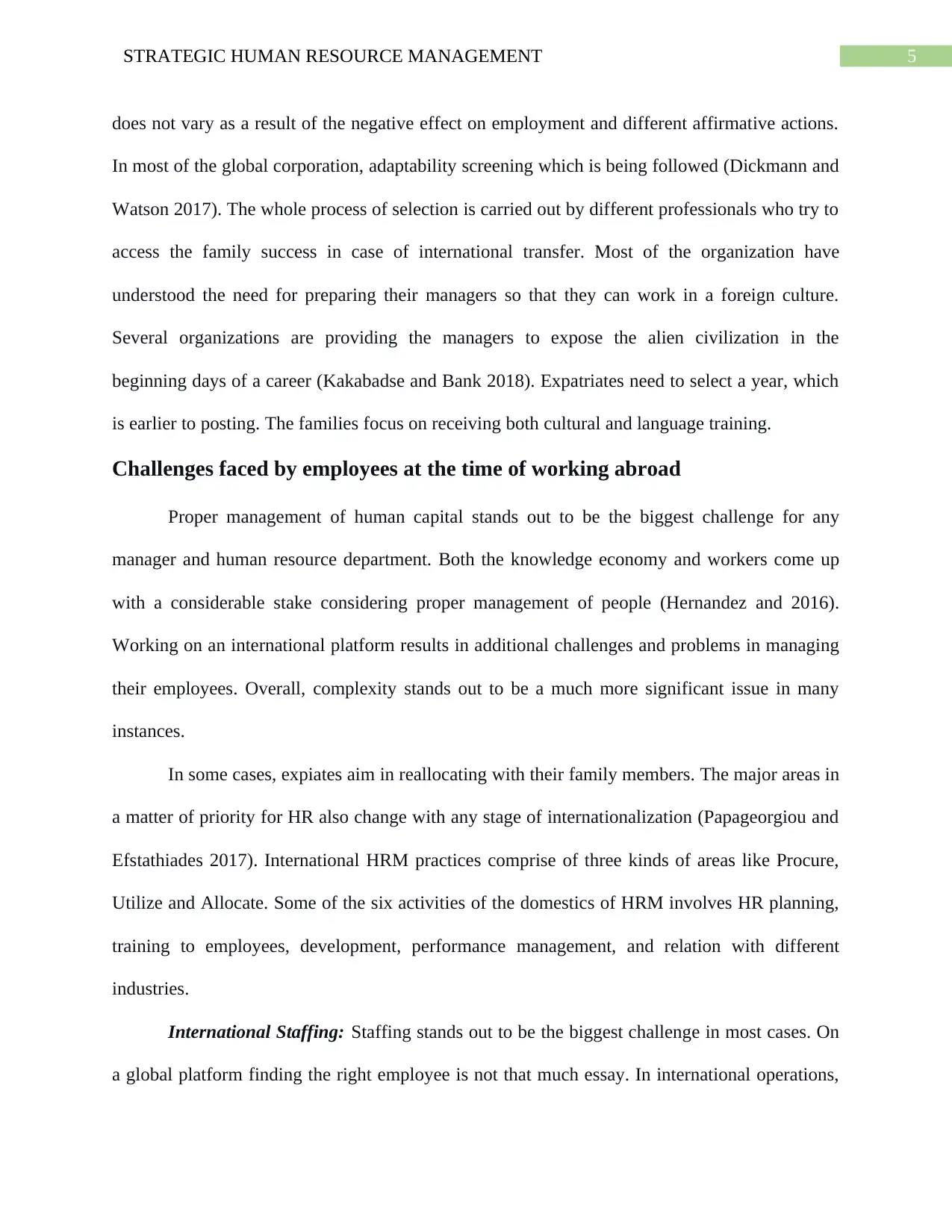
5STRATEGIC HUMAN RESOURCE MANAGEMENT
does not vary as a result of the negative effect on employment and different affirmative actions.
In most of the global corporation, adaptability screening which is being followed (Dickmann and
Watson 2017). The whole process of selection is carried out by different professionals who try to
access the family success in case of international transfer. Most of the organization have
understood the need for preparing their managers so that they can work in a foreign culture.
Several organizations are providing the managers to expose the alien civilization in the
beginning days of a career (Kakabadse and Bank 2018). Expatriates need to select a year, which
is earlier to posting. The families focus on receiving both cultural and language training.
Challenges faced by employees at the time of working abroad
Proper management of human capital stands out to be the biggest challenge for any
manager and human resource department. Both the knowledge economy and workers come up
with a considerable stake considering proper management of people (Hernandez and 2016).
Working on an international platform results in additional challenges and problems in managing
their employees. Overall, complexity stands out to be a much more significant issue in many
instances.
In some cases, expiates aim in reallocating with their family members. The major areas in
a matter of priority for HR also change with any stage of internationalization (Papageorgiou and
Efstathiades 2017). International HRM practices comprise of three kinds of areas like Procure,
Utilize and Allocate. Some of the six activities of the domestics of HRM involves HR planning,
training to employees, development, performance management, and relation with different
industries.
International Staffing: Staffing stands out to be the biggest challenge in most cases. On
a global platform finding the right employee is not that much essay. In international operations,
does not vary as a result of the negative effect on employment and different affirmative actions.
In most of the global corporation, adaptability screening which is being followed (Dickmann and
Watson 2017). The whole process of selection is carried out by different professionals who try to
access the family success in case of international transfer. Most of the organization have
understood the need for preparing their managers so that they can work in a foreign culture.
Several organizations are providing the managers to expose the alien civilization in the
beginning days of a career (Kakabadse and Bank 2018). Expatriates need to select a year, which
is earlier to posting. The families focus on receiving both cultural and language training.
Challenges faced by employees at the time of working abroad
Proper management of human capital stands out to be the biggest challenge for any
manager and human resource department. Both the knowledge economy and workers come up
with a considerable stake considering proper management of people (Hernandez and 2016).
Working on an international platform results in additional challenges and problems in managing
their employees. Overall, complexity stands out to be a much more significant issue in many
instances.
In some cases, expiates aim in reallocating with their family members. The major areas in
a matter of priority for HR also change with any stage of internationalization (Papageorgiou and
Efstathiades 2017). International HRM practices comprise of three kinds of areas like Procure,
Utilize and Allocate. Some of the six activities of the domestics of HRM involves HR planning,
training to employees, development, performance management, and relation with different
industries.
International Staffing: Staffing stands out to be the biggest challenge in most cases. On
a global platform finding the right employee is not that much essay. In international operations,
⊘ This is a preview!⊘
Do you want full access?
Subscribe today to unlock all pages.

Trusted by 1+ million students worldwide

6STRATEGIC HUMAN RESOURCE MANAGEMENT
the complexity of staffing stands out to be a bit tricky. Mixing both local employees with
expiates is not that much easy decision to make (Clark 2017). There is a list of factors that can
impact a similar thing. The overall cost of finding an international employee, along with hiring
that particular individual, stands to be much high. Much of the cost expectation stands out to be
much more in case of careful consideration and its selection. There is a list of treaties related to
tax in between most of the countries where there is an obligation of income tax (Yuniarto 2016).
This kind of agreement can make hire from different countries much easy. It also focuses on
environmental factors and international staffing.
Cultural challenges: As a result of the difference in the national culture, the ex-pats
impose a considerable number of problems for hiring and complete the assimilating of
international staff. Most of the pre-department training aims to play a vital role in project success
and different international assignments (Benz 2016). Most of the MNCs come up with
developing strategies along with training intervention so that it can cope with different kinds of
cultural issues. Hofstede even worked on cultural aspects which help in addressing national
culture and difference of religion in most of the countries (Bailey et al. 2018). Hofstede aims to
define the cultural dimension, which helps in qualifying the national culture. There are mainly
six areas of the aesthetic aspect in Hofstede are
Power Distance Index (PDI): The value to which the less powerful members in society
accept and ultimately expects the power distribution unequally.
Individualism vs Collectivism: Much of the preferences is given on social framework. It
will help them in caring themselves and family members.
Masculinity vs Femininity: The masculinity aspect of dimension aims to represent a
complete preference in the whole society, needed for social achievements.
the complexity of staffing stands out to be a bit tricky. Mixing both local employees with
expiates is not that much easy decision to make (Clark 2017). There is a list of factors that can
impact a similar thing. The overall cost of finding an international employee, along with hiring
that particular individual, stands to be much high. Much of the cost expectation stands out to be
much more in case of careful consideration and its selection. There is a list of treaties related to
tax in between most of the countries where there is an obligation of income tax (Yuniarto 2016).
This kind of agreement can make hire from different countries much easy. It also focuses on
environmental factors and international staffing.
Cultural challenges: As a result of the difference in the national culture, the ex-pats
impose a considerable number of problems for hiring and complete the assimilating of
international staff. Most of the pre-department training aims to play a vital role in project success
and different international assignments (Benz 2016). Most of the MNCs come up with
developing strategies along with training intervention so that it can cope with different kinds of
cultural issues. Hofstede even worked on cultural aspects which help in addressing national
culture and difference of religion in most of the countries (Bailey et al. 2018). Hofstede aims to
define the cultural dimension, which helps in qualifying the national culture. There are mainly
six areas of the aesthetic aspect in Hofstede are
Power Distance Index (PDI): The value to which the less powerful members in society
accept and ultimately expects the power distribution unequally.
Individualism vs Collectivism: Much of the preferences is given on social framework. It
will help them in caring themselves and family members.
Masculinity vs Femininity: The masculinity aspect of dimension aims to represent a
complete preference in the whole society, needed for social achievements.
Paraphrase This Document
Need a fresh take? Get an instant paraphrase of this document with our AI Paraphraser
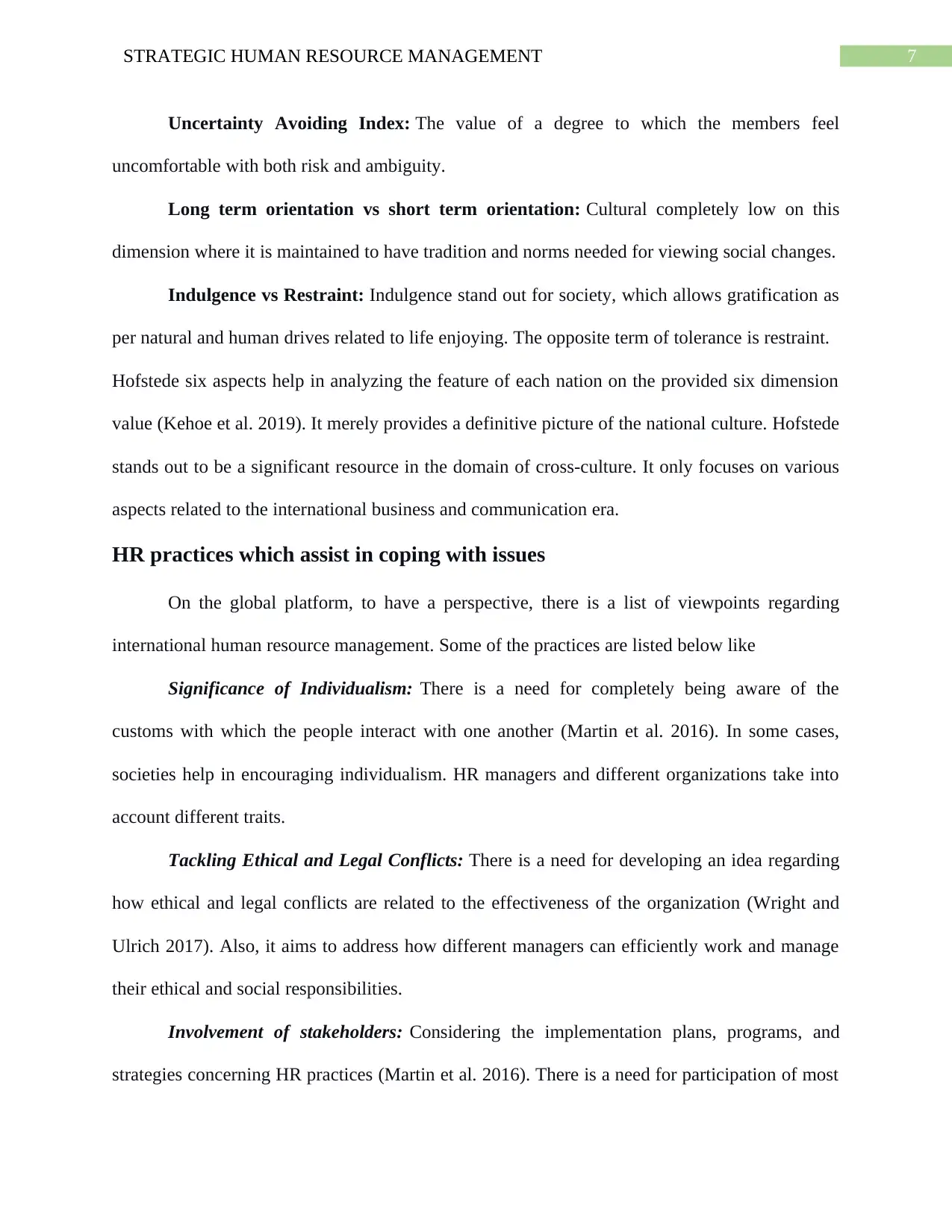
7STRATEGIC HUMAN RESOURCE MANAGEMENT
Uncertainty Avoiding Index: The value of a degree to which the members feel
uncomfortable with both risk and ambiguity.
Long term orientation vs short term orientation: Cultural completely low on this
dimension where it is maintained to have tradition and norms needed for viewing social changes.
Indulgence vs Restraint: Indulgence stand out for society, which allows gratification as
per natural and human drives related to life enjoying. The opposite term of tolerance is restraint.
Hofstede six aspects help in analyzing the feature of each nation on the provided six dimension
value (Kehoe et al. 2019). It merely provides a definitive picture of the national culture. Hofstede
stands out to be a significant resource in the domain of cross-culture. It only focuses on various
aspects related to the international business and communication era.
HR practices which assist in coping with issues
On the global platform, to have a perspective, there is a list of viewpoints regarding
international human resource management. Some of the practices are listed below like
Significance of Individualism: There is a need for completely being aware of the
customs with which the people interact with one another (Martin et al. 2016). In some cases,
societies help in encouraging individualism. HR managers and different organizations take into
account different traits.
Tackling Ethical and Legal Conflicts: There is a need for developing an idea regarding
how ethical and legal conflicts are related to the effectiveness of the organization (Wright and
Ulrich 2017). Also, it aims to address how different managers can efficiently work and manage
their ethical and social responsibilities.
Involvement of stakeholders: Considering the implementation plans, programs, and
strategies concerning HR practices (Martin et al. 2016). There is a need for participation of most
Uncertainty Avoiding Index: The value of a degree to which the members feel
uncomfortable with both risk and ambiguity.
Long term orientation vs short term orientation: Cultural completely low on this
dimension where it is maintained to have tradition and norms needed for viewing social changes.
Indulgence vs Restraint: Indulgence stand out for society, which allows gratification as
per natural and human drives related to life enjoying. The opposite term of tolerance is restraint.
Hofstede six aspects help in analyzing the feature of each nation on the provided six dimension
value (Kehoe et al. 2019). It merely provides a definitive picture of the national culture. Hofstede
stands out to be a significant resource in the domain of cross-culture. It only focuses on various
aspects related to the international business and communication era.
HR practices which assist in coping with issues
On the global platform, to have a perspective, there is a list of viewpoints regarding
international human resource management. Some of the practices are listed below like
Significance of Individualism: There is a need for completely being aware of the
customs with which the people interact with one another (Martin et al. 2016). In some cases,
societies help in encouraging individualism. HR managers and different organizations take into
account different traits.
Tackling Ethical and Legal Conflicts: There is a need for developing an idea regarding
how ethical and legal conflicts are related to the effectiveness of the organization (Wright and
Ulrich 2017). Also, it aims to address how different managers can efficiently work and manage
their ethical and social responsibilities.
Involvement of stakeholders: Considering the implementation plans, programs, and
strategies concerning HR practices (Martin et al. 2016). There is a need for participation of most
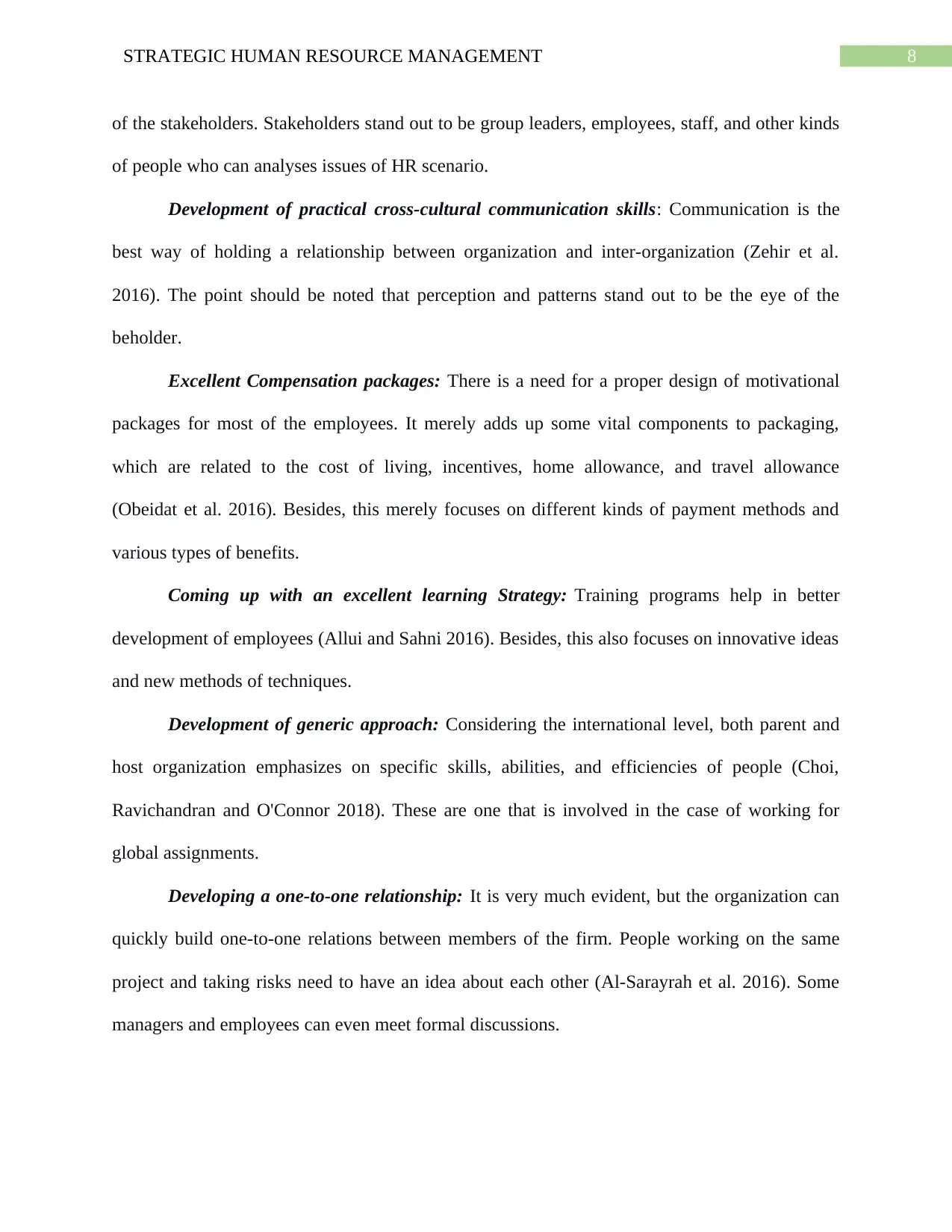
8STRATEGIC HUMAN RESOURCE MANAGEMENT
of the stakeholders. Stakeholders stand out to be group leaders, employees, staff, and other kinds
of people who can analyses issues of HR scenario.
Development of practical cross-cultural communication skills: Communication is the
best way of holding a relationship between organization and inter-organization (Zehir et al.
2016). The point should be noted that perception and patterns stand out to be the eye of the
beholder.
Excellent Compensation packages: There is a need for a proper design of motivational
packages for most of the employees. It merely adds up some vital components to packaging,
which are related to the cost of living, incentives, home allowance, and travel allowance
(Obeidat et al. 2016). Besides, this merely focuses on different kinds of payment methods and
various types of benefits.
Coming up with an excellent learning Strategy: Training programs help in better
development of employees (Allui and Sahni 2016). Besides, this also focuses on innovative ideas
and new methods of techniques.
Development of generic approach: Considering the international level, both parent and
host organization emphasizes on specific skills, abilities, and efficiencies of people (Choi,
Ravichandran and O'Connor 2018). These are one that is involved in the case of working for
global assignments.
Developing a one-to-one relationship: It is very much evident, but the organization can
quickly build one-to-one relations between members of the firm. People working on the same
project and taking risks need to have an idea about each other (Al-Sarayrah et al. 2016). Some
managers and employees can even meet formal discussions.
of the stakeholders. Stakeholders stand out to be group leaders, employees, staff, and other kinds
of people who can analyses issues of HR scenario.
Development of practical cross-cultural communication skills: Communication is the
best way of holding a relationship between organization and inter-organization (Zehir et al.
2016). The point should be noted that perception and patterns stand out to be the eye of the
beholder.
Excellent Compensation packages: There is a need for a proper design of motivational
packages for most of the employees. It merely adds up some vital components to packaging,
which are related to the cost of living, incentives, home allowance, and travel allowance
(Obeidat et al. 2016). Besides, this merely focuses on different kinds of payment methods and
various types of benefits.
Coming up with an excellent learning Strategy: Training programs help in better
development of employees (Allui and Sahni 2016). Besides, this also focuses on innovative ideas
and new methods of techniques.
Development of generic approach: Considering the international level, both parent and
host organization emphasizes on specific skills, abilities, and efficiencies of people (Choi,
Ravichandran and O'Connor 2018). These are one that is involved in the case of working for
global assignments.
Developing a one-to-one relationship: It is very much evident, but the organization can
quickly build one-to-one relations between members of the firm. People working on the same
project and taking risks need to have an idea about each other (Al-Sarayrah et al. 2016). Some
managers and employees can even meet formal discussions.
⊘ This is a preview!⊘
Do you want full access?
Subscribe today to unlock all pages.

Trusted by 1+ million students worldwide
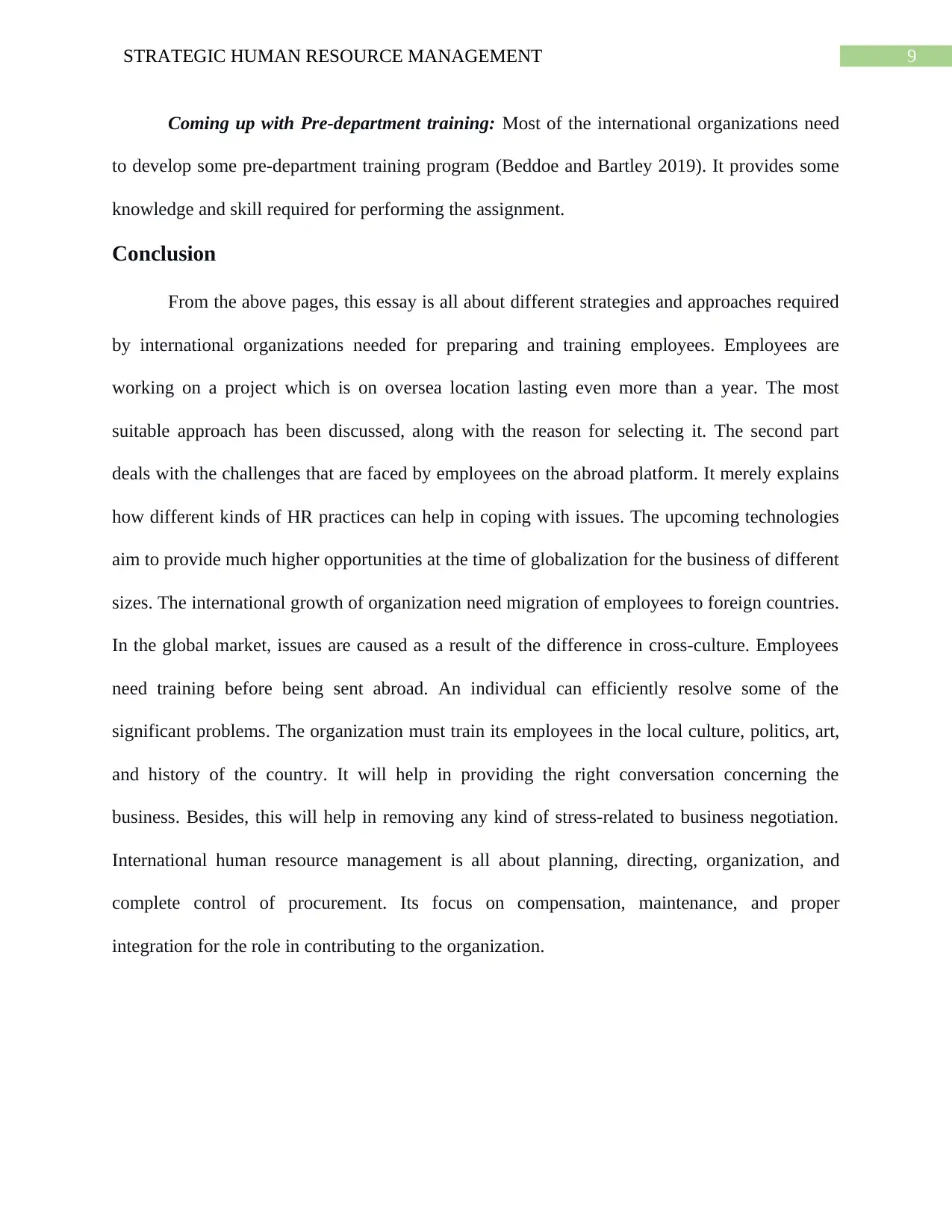
9STRATEGIC HUMAN RESOURCE MANAGEMENT
Coming up with Pre-department training: Most of the international organizations need
to develop some pre-department training program (Beddoe and Bartley 2019). It provides some
knowledge and skill required for performing the assignment.
Conclusion
From the above pages, this essay is all about different strategies and approaches required
by international organizations needed for preparing and training employees. Employees are
working on a project which is on oversea location lasting even more than a year. The most
suitable approach has been discussed, along with the reason for selecting it. The second part
deals with the challenges that are faced by employees on the abroad platform. It merely explains
how different kinds of HR practices can help in coping with issues. The upcoming technologies
aim to provide much higher opportunities at the time of globalization for the business of different
sizes. The international growth of organization need migration of employees to foreign countries.
In the global market, issues are caused as a result of the difference in cross-culture. Employees
need training before being sent abroad. An individual can efficiently resolve some of the
significant problems. The organization must train its employees in the local culture, politics, art,
and history of the country. It will help in providing the right conversation concerning the
business. Besides, this will help in removing any kind of stress-related to business negotiation.
International human resource management is all about planning, directing, organization, and
complete control of procurement. Its focus on compensation, maintenance, and proper
integration for the role in contributing to the organization.
Coming up with Pre-department training: Most of the international organizations need
to develop some pre-department training program (Beddoe and Bartley 2019). It provides some
knowledge and skill required for performing the assignment.
Conclusion
From the above pages, this essay is all about different strategies and approaches required
by international organizations needed for preparing and training employees. Employees are
working on a project which is on oversea location lasting even more than a year. The most
suitable approach has been discussed, along with the reason for selecting it. The second part
deals with the challenges that are faced by employees on the abroad platform. It merely explains
how different kinds of HR practices can help in coping with issues. The upcoming technologies
aim to provide much higher opportunities at the time of globalization for the business of different
sizes. The international growth of organization need migration of employees to foreign countries.
In the global market, issues are caused as a result of the difference in cross-culture. Employees
need training before being sent abroad. An individual can efficiently resolve some of the
significant problems. The organization must train its employees in the local culture, politics, art,
and history of the country. It will help in providing the right conversation concerning the
business. Besides, this will help in removing any kind of stress-related to business negotiation.
International human resource management is all about planning, directing, organization, and
complete control of procurement. Its focus on compensation, maintenance, and proper
integration for the role in contributing to the organization.
Paraphrase This Document
Need a fresh take? Get an instant paraphrase of this document with our AI Paraphraser
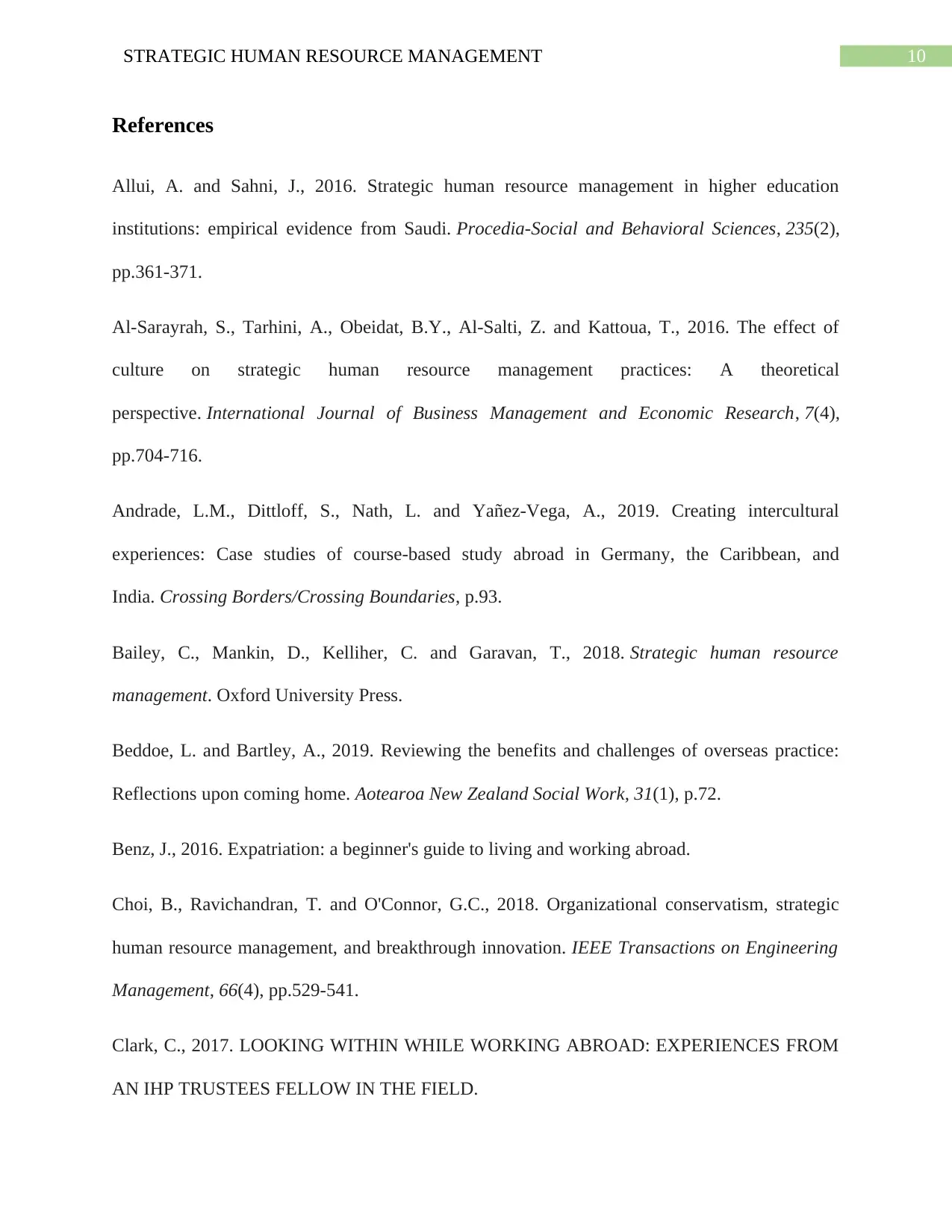
10STRATEGIC HUMAN RESOURCE MANAGEMENT
References
Allui, A. and Sahni, J., 2016. Strategic human resource management in higher education
institutions: empirical evidence from Saudi. Procedia-Social and Behavioral Sciences, 235(2),
pp.361-371.
Al-Sarayrah, S., Tarhini, A., Obeidat, B.Y., Al-Salti, Z. and Kattoua, T., 2016. The effect of
culture on strategic human resource management practices: A theoretical
perspective. International Journal of Business Management and Economic Research, 7(4),
pp.704-716.
Andrade, L.M., Dittloff, S., Nath, L. and Yañez-Vega, A., 2019. Creating intercultural
experiences: Case studies of course-based study abroad in Germany, the Caribbean, and
India. Crossing Borders/Crossing Boundaries, p.93.
Bailey, C., Mankin, D., Kelliher, C. and Garavan, T., 2018. Strategic human resource
management. Oxford University Press.
Beddoe, L. and Bartley, A., 2019. Reviewing the benefits and challenges of overseas practice:
Reflections upon coming home. Aotearoa New Zealand Social Work, 31(1), p.72.
Benz, J., 2016. Expatriation: a beginner's guide to living and working abroad.
Choi, B., Ravichandran, T. and O'Connor, G.C., 2018. Organizational conservatism, strategic
human resource management, and breakthrough innovation. IEEE Transactions on Engineering
Management, 66(4), pp.529-541.
Clark, C., 2017. LOOKING WITHIN WHILE WORKING ABROAD: EXPERIENCES FROM
AN IHP TRUSTEES FELLOW IN THE FIELD.
References
Allui, A. and Sahni, J., 2016. Strategic human resource management in higher education
institutions: empirical evidence from Saudi. Procedia-Social and Behavioral Sciences, 235(2),
pp.361-371.
Al-Sarayrah, S., Tarhini, A., Obeidat, B.Y., Al-Salti, Z. and Kattoua, T., 2016. The effect of
culture on strategic human resource management practices: A theoretical
perspective. International Journal of Business Management and Economic Research, 7(4),
pp.704-716.
Andrade, L.M., Dittloff, S., Nath, L. and Yañez-Vega, A., 2019. Creating intercultural
experiences: Case studies of course-based study abroad in Germany, the Caribbean, and
India. Crossing Borders/Crossing Boundaries, p.93.
Bailey, C., Mankin, D., Kelliher, C. and Garavan, T., 2018. Strategic human resource
management. Oxford University Press.
Beddoe, L. and Bartley, A., 2019. Reviewing the benefits and challenges of overseas practice:
Reflections upon coming home. Aotearoa New Zealand Social Work, 31(1), p.72.
Benz, J., 2016. Expatriation: a beginner's guide to living and working abroad.
Choi, B., Ravichandran, T. and O'Connor, G.C., 2018. Organizational conservatism, strategic
human resource management, and breakthrough innovation. IEEE Transactions on Engineering
Management, 66(4), pp.529-541.
Clark, C., 2017. LOOKING WITHIN WHILE WORKING ABROAD: EXPERIENCES FROM
AN IHP TRUSTEES FELLOW IN THE FIELD.
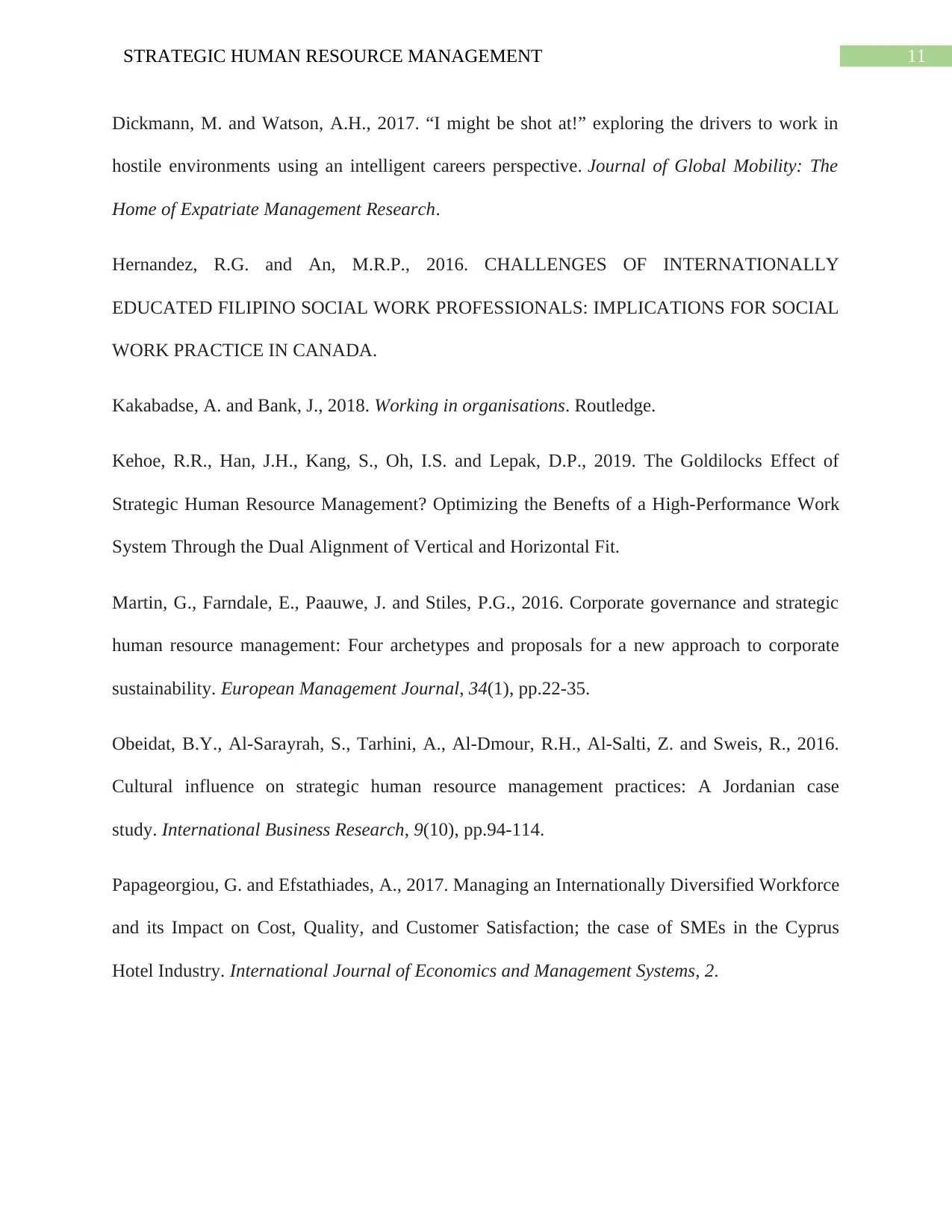
11STRATEGIC HUMAN RESOURCE MANAGEMENT
Dickmann, M. and Watson, A.H., 2017. “I might be shot at!” exploring the drivers to work in
hostile environments using an intelligent careers perspective. Journal of Global Mobility: The
Home of Expatriate Management Research.
Hernandez, R.G. and An, M.R.P., 2016. CHALLENGES OF INTERNATIONALLY
EDUCATED FILIPINO SOCIAL WORK PROFESSIONALS: IMPLICATIONS FOR SOCIAL
WORK PRACTICE IN CANADA.
Kakabadse, A. and Bank, J., 2018. Working in organisations. Routledge.
Kehoe, R.R., Han, J.H., Kang, S., Oh, I.S. and Lepak, D.P., 2019. The Goldilocks Effect of
Strategic Human Resource Management? Optimizing the Benefts of a High-Performance Work
System Through the Dual Alignment of Vertical and Horizontal Fit.
Martin, G., Farndale, E., Paauwe, J. and Stiles, P.G., 2016. Corporate governance and strategic
human resource management: Four archetypes and proposals for a new approach to corporate
sustainability. European Management Journal, 34(1), pp.22-35.
Obeidat, B.Y., Al-Sarayrah, S., Tarhini, A., Al-Dmour, R.H., Al-Salti, Z. and Sweis, R., 2016.
Cultural influence on strategic human resource management practices: A Jordanian case
study. International Business Research, 9(10), pp.94-114.
Papageorgiou, G. and Efstathiades, A., 2017. Managing an Internationally Diversified Workforce
and its Impact on Cost, Quality, and Customer Satisfaction; the case of SMEs in the Cyprus
Hotel Industry. International Journal of Economics and Management Systems, 2.
Dickmann, M. and Watson, A.H., 2017. “I might be shot at!” exploring the drivers to work in
hostile environments using an intelligent careers perspective. Journal of Global Mobility: The
Home of Expatriate Management Research.
Hernandez, R.G. and An, M.R.P., 2016. CHALLENGES OF INTERNATIONALLY
EDUCATED FILIPINO SOCIAL WORK PROFESSIONALS: IMPLICATIONS FOR SOCIAL
WORK PRACTICE IN CANADA.
Kakabadse, A. and Bank, J., 2018. Working in organisations. Routledge.
Kehoe, R.R., Han, J.H., Kang, S., Oh, I.S. and Lepak, D.P., 2019. The Goldilocks Effect of
Strategic Human Resource Management? Optimizing the Benefts of a High-Performance Work
System Through the Dual Alignment of Vertical and Horizontal Fit.
Martin, G., Farndale, E., Paauwe, J. and Stiles, P.G., 2016. Corporate governance and strategic
human resource management: Four archetypes and proposals for a new approach to corporate
sustainability. European Management Journal, 34(1), pp.22-35.
Obeidat, B.Y., Al-Sarayrah, S., Tarhini, A., Al-Dmour, R.H., Al-Salti, Z. and Sweis, R., 2016.
Cultural influence on strategic human resource management practices: A Jordanian case
study. International Business Research, 9(10), pp.94-114.
Papageorgiou, G. and Efstathiades, A., 2017. Managing an Internationally Diversified Workforce
and its Impact on Cost, Quality, and Customer Satisfaction; the case of SMEs in the Cyprus
Hotel Industry. International Journal of Economics and Management Systems, 2.
⊘ This is a preview!⊘
Do you want full access?
Subscribe today to unlock all pages.

Trusted by 1+ million students worldwide
1 out of 13
Related Documents
Your All-in-One AI-Powered Toolkit for Academic Success.
+13062052269
info@desklib.com
Available 24*7 on WhatsApp / Email
![[object Object]](/_next/static/media/star-bottom.7253800d.svg)
Unlock your academic potential
Copyright © 2020–2025 A2Z Services. All Rights Reserved. Developed and managed by ZUCOL.



